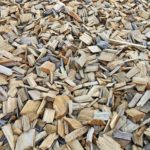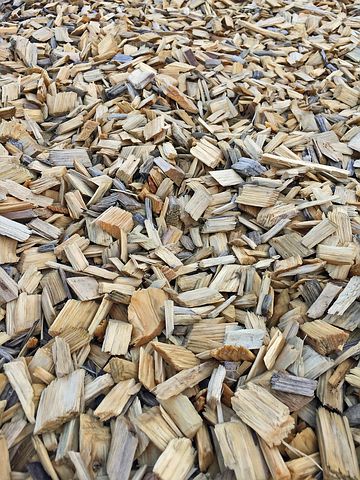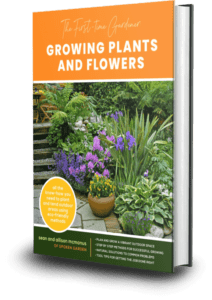Learn basic steps to begin spreading mulch in your garden areas today!
You can mulch any time of year and we’re here to help teach you how to mulch in 6 basic steps.
When was the last time you gave your garden a good mulching as part of your regular garden care routine?
Most gardeners create yearly, quarterly, monthly, or even weekly to-do lists that include monitoring 
However, a good mulch can be just as important to your plants as every other project on your list.
In this post, we will explain why mulching any time of the year is acceptable, and provide you with tips and tricks to teach you how to better mulch your garden.
We even have mulching hacks to share!
But first, the basics.
What is Mulching or Garden Mulching?
Mulching is the act of moving, spreading, and placing natural or synthetic material in and around your plants and garden beds.
Mulch itself is any material that is used for covering a garden bed area for the purpose of:
- Weed control
- Soil moisture retention
- Root protection from heat or cold
- Encouraging soil microorganisms
- Improving general soil health
- Improving soil drainage
- Reducing soil erosion
- Enhancing the aesthetics of your garden
- Provide protection from mechanical equipment
- Reducing soil compaction
If you want to know more about mulching, go to our Mulching Start Here page.
If you are looking for Summer Flowering Bulbs to add to your garden, look no further than our ebook
21 Spring-Planted Bulbs For Fantastic Summer Color!
It’s has 60+ pages of summer flowering bulb inspiration and you can get to know the different plant care needs of these 21 gorgeous spring-
planted, summer-flowering bulbs. Whether you are already familiar with bulbs or are just learning about them, this guide explains what bulbs are, defines the 5 different types of bulbs, the correct planting orientation for each of the 5, and much more.
You also get to know each of these 21 spring-planted, summer-flowering bulbs intimately for their care needs like where they will grow, when they flower, different flower colors they are available in, and which online-retailers you can buy your very own to then add to your garden.
Grab your copy now and start planning your spring and summer flower garden TODAY!
Why Mulch?
Not convinced yet that mulching should be at the top of your garden maintenance to-do list?
The act of mulching can enhance a plant’s health and lengthen its longevity in your garden in so many ways.
For this reason alone, we want to educate you about the benefits of mulching so that you can take pride in your beautiful outdoor space.
How Much Mulch Should You Put Down?
If if you are laying down mulch for the first time or initially in your garden, then you should start out with 4-6 inches deep with a naturally sourced mulch, like Arborist Mulch or Wood Chip from Cedar, Pine, Fir, Maple, or other tree sources.
The reason to initially place the mulch so deep is that it will settle and decompose where it compresses over the first one to two months, and even more so if it is being walked on or driven over repeatedly.
If you are adding mulch over older mulch in your garden, then a light added layer of 1-2 inches average depth is fine.
If the old mulch is thin, like only 1-2 inches deep or less, then you should add more mulch from 2 to 4 inches so you have the weed barrier re-established along with the added insulation in your garden bed.
How Often Do You Have to Mulch?
Good mulching consists of a mulch thickness of 2-4 inches. At this depth, the mulch should last a typical garden about 1.5 to 2 years with some weeding.
Yes, there will still be weeding to do, but not as bad as if you hadn’t mulched at all.
The longevity of the mulch will depend on temperature, moisture, and the local microorganisms ability to break it down.
Should You Remove Old Mulch?
It depends …. really, on the mulch you have in your garden currently.
If it’s a naturally sourced mulch and adds nutrients to your garden soil AND also builds more soil as it breaks down, along with being a great insulator and can control erosion, along with my other benefits, then you should definitely keep your old mulch.
If you also are using a wood chip mulch that is intended for weed suppression and also for foot paths where as it breaks down it still does it’s job then you should keep it and add more on top.
If your current mulch in your garden doesn’t build soil, add nutrients, or is creating an issue with mushy, boggy areas that you don’t want, then this old mulch should first be removed before adding to it.
This can be very dependent on temperature and sun exposure, along with rain and any type of traffic in your garden. Also the type of mulch material you area using.
What Are the Best Types of Mulch?
Mulch can come from natural or synthetic sources.
Also, the variety of mulch options come in different colors, shapes, sizes, and textures.
Be careful when buying the mulch material that you are purchasing it from a reputable source.
You do not want to buy cheap mulch and risk it being riddled with weed seeds or anything else that could cause more problems down the road.
Natural Mulch Examples:
- Chipped or shredded wood: Arborist Chip, Bark Chip, or Sawdust

Bark Mulch
- Tree or shrub leaves: waxy leaves (Laurel or Oak), unwaxy leaves (Maple, Birch, or Willow)
- Compost: raw, partially, or mostly broken down materials from different natural sources
- Burlap bags: hemp
- Rock: pebbles, aggregate, shale, lava, limestone, concrete chunks, or other decorative rocks
Manufactured or Synthetic Mulch Examples:
- Burlap bags: plastic

Newspaper Mulch
- Cardboard sheets in various sizes
- Newspaper
- Plastic sheets: white, black, clear
- Landscape fabric or other weaved materials
Based on your needs or the needs of your garden, choose the best type of mulch for you based on its specific use and your local climatic conditions.



